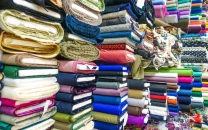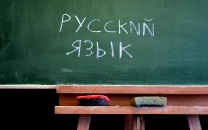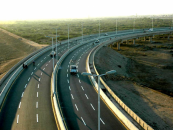SBP buys over $5b from interbank
Purchase equals two-thirds of forex reserves, far higher than IMF’s bailout

The central bank has purchased over $5 billion from the market during this fiscal year, a record amount that is equal to two-thirds of Pakistan’s official foreign exchange reserves and also far higher than the size of the International Monetary Fund (IMF) bailout package.
While the central bank’s intervention has kept foreign currency reserves stable at $8 billion despite heavy debt repayments, it has also contributed to keeping the value of the rupee low at Rs278 to a dollar. In the absence of these interventions, the parity should have been below Rs250 to a dollar, according to independent analysts.
Government and central bank sources told The Express Tribune that these purchases were made to prevent official foreign exchange reserves from sliding below $3 billion due to the absence of major inflows of foreign loans. They said the central bank has purchased much more than $5 billion, and the buying was still continuing.
One source said that the total size of the purchases was around $5.5 billion.
The central bank avoids responding to questions about the sale and purchase of foreign currency. It has kept the massive intervention in the interbank market under the carpet, involving over Rs1.4 trillion transactions to buy at least $5 billion. It is rare for the central bank’s purchases to exceed the size of the $3 billion IMF programme. One reason for entering the IMF programme was to secure additional loans and build reserves. However, the country has only received $9.7 billion in foreign loans so far, insufficient to cover foreign debt repayments and finance the current account deficit.
Ashfaq Yousaf Tola, a Chartered Accountant and former chairman of the Revenue and Resource Mobilisation Commission, stated that due to the central bank’s purchases, the rupee was undervalued by Rs40-45 to a dollar, contributing to high inflation of at least 5%.
Tola stressed that it would be in the government’s interest to bring the real rupee-dollar parity to Rs235 by ending intervention in the market. He suggested that a 5% reduction in the inflation rate would help lower interest rates, potentially saving the government at least Rs2.5 trillion annually in interest costs.
However, Pakistani authorities argue that if the central bank had not purchased dollars, reserves would have fallen to $3 billion, leading to even higher inflation. They fear a repeat of the pre-June 2022 episode, where reserves were critically low.
The inflation-adjusted value of the rupee-dollar works out to around Rs243 for March 2024 based on cumulative inflation differentials between Pakistan and the US, said Asif Qureshi, Chief Executive of Optimus Capital Management.
The central bank was purchasing dollars from the interbank market. Had this money been available in the market, foreign firms would have enough dollars to repatriate their profits.
Tola pointed out that with the rupee valued at Rs278, exporters were receiving Rs35 to Rs45 more for every dollar of their export proceeds.
The last IMF report had also stated that on the back of disbursements by the international financial institutions and continued SBP purchases, gross reserves further increased. However, despite an increase in gross reserves, the cushion is still insufficient to back 1.4 months of imports.
Pakistan is again seeking a minimum $6 billion new IMF programme, and the central bank’s purchases in less than 10 months were equal to 85% of the size of the three-year programme.
Since June 2019, Pakistan has adopted a market-based flexible exchange rate system, where the exchange rate is determined by market demand and supply conditions. The central bank’s intervention to purchase dollars also goes against the principle of a market-based exchange rate.
Independent analysts believe that the rupee value has been over-adjusted, and the current account deficit figures suggest that imports at Rs278 to a dollar are no longer viable.
One reason for the central bank’s intervention was the Ministry of Finance’s failure to ensure inflows of $6 billion from Eurobonds and foreign commercial loans. Data from the Economic Affairs Division and the central bank showed that Pakistan secured $9.7 billion in foreign loans during the first nine months of the fiscal year, slightly over 50% of the annual budget estimates.
If the rupee value improves to below Rs250 to a dollar, the government will have room to cut petrol prices by at least Rs40 per litre.
Pakistan’s heavy reliance on energy imports, comprising approximately 34% of its total import bill, leaves it vulnerable to fluctuations in global oil prices and exchange rate variations.
Pakistani authorities claim that the Real Effective Exchange Rate (REER), a measure of the value of a currency against a weighted average of several foreign currencies, increased to 104.07 in March 2024, indicating that the rupee was not undervalued. This is the highest level for the REER since April 2021, according to the central bank.
A REER below 100 means the country’s exports are competitive, while imports are expensive. The situation reverses when REER stands above 100 on the index.
Finance Minister Muhammad Aurangzeb last week in Washington termed the 6% to 8% rupee devaluation normal. However, independent experts believe there is no further room for devaluation and instead suggest strengthening the rupee value by 14% to 20%.
Published in The Express Tribune, April 26th, 2024.
Like Business on Facebook, follow @TribuneBiz on Twitter to stay informed and join in the conversation.



















COMMENTS
Comments are moderated and generally will be posted if they are on-topic and not abusive.
For more information, please see our Comments FAQ